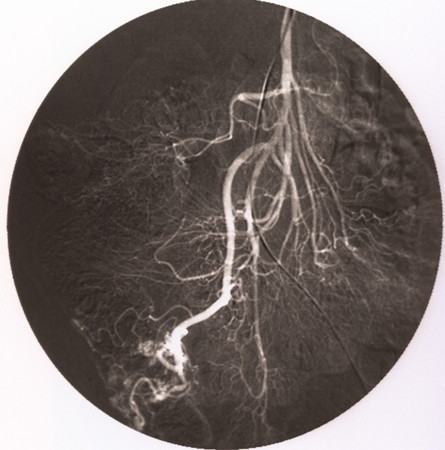Resumo
Definição
História e exame físico
Principais fatores diagnósticos
- gastrointestinal bleeding
Outros fatores diagnósticos
- age >60 years
- shortness of breath
- fatigue
- pallor
- tachycardia
- hypotension
Fatores de risco
- chronic renal failure/end-stage renal disease
- von Willebrand disease
- aortic stenosis
- scleroderma
- cardiovascular disease
- increasing age
Investigações diagnósticas
Primeiras investigações a serem solicitadas
- CBC
- blood type and crossmatch
- blood chemistry
- coagulation status
- esophagogastroduodenoscopy
- push enteroscopy
- colonoscopy
Investigações a serem consideradas
- wireless capsule enteroscopy
- CT angiography
- selective mesenteric angiography
- technetium Tc-99m radionuclide scan
- CT enterography
- device-assisted enteroscopy
Novos exames
- magnetic resonance angiography
Algoritmo de tratamento
hemodynamically unstable (severe hemorrhage)
hemodynamically stable
recurrent bleed
Colaboradores
Autores
Reena Sidhu, MD, FRCP
Consultant Gastroenterologist
Royal Hallamshire Hospital
Sheffield Teaching Hospitals NHS Foundation Trust
Hon Professor
Division of Clinical Medicine
School of Medicine and Population Health
University of Sheffield
Sheffield
UK
Declarações
RS has received speaker fees and congress travel grants (Dr Falk 2021 & 2023). RS has attended ANx Robotica symposium 2023. RS is an author of a reference cited in this topic.
Nicoletta Nandi, MD
Clinical Fellow
Academic Unit of Gastroenterology
Sheffield Teaching Hospitals NHS Foundation Trust
Sheffield
UK
Declarações
NN declares that she has no competing interests.
Agradecimentos
Prof Reena Sidhu and Dr Nicoletta Nandi would like to gratefully acknowledge Dr Aidan Shaw, Dr Heather Lee, and Dr William Speake, previous contributors to this topic.
Declarações
AS, HL, and WS declare that they have no competing interests.
Revisores
Brooks D. Cash, MD, AGAF, FACG, FACP, FASGE
BMJ Best Practice Gastroenterology expert panel member
Professor of Medicine
University of Texas Health Science Center at Houston
Houston
TX
Declarações
BDC declares that he has no competing interests.
Créditos aos pareceristas
Os tópicos do BMJ Best Practice são constantemente atualizados, seguindo os desenvolvimentos das evidências e das diretrizes. Os pareceristas aqui listados revisaram o conteúdo pelo menos uma vez durante a história do tópico.
Declarações
As afiliações e declarações dos pareceristas referem--se ao momento da revisão.
Referências
Principais artigos
Gerson LB, Fidler JL, Cave DR, et al. ACG clinical guideline: diagnosis and management of small bowel bleeding. Am J Gastroenterol. 2015 Sep;110(9):1265-87; quiz 1288.Texto completo Resumo
Sengupta N, Kastenberg DM, Bruining DH, et al. The role of imaging for GI bleeding: ACG and SAR consensus recommendations. Radiology. 2024 Mar;310(3):e232298. Resumo
Triantafyllou K, Gkolfakis P, Gralnek IM, et al. Diagnosis and management of acute lower gastrointestinal bleeding: European Society of Gastrointestinal Endoscopy (ESGE) guideline. Endoscopy. 2021 Aug;53(8):850-68.Texto completo Resumo
Artigos de referência
Uma lista completa das fontes referenciadas neste tópico está disponível para os usuários com acesso total ao BMJ Best Practice.

Diagnósticos diferenciais
- Diverticular disease
- Colorectal cancer
- Gastrointestinal stromal tumors and leiomyomas
Mais Diagnósticos diferenciaisDiretrizes
- The role of imaging for GI bleeding: ACG and SAR consensus recommendations
- Management of patients with acute lower gastrointestinal bleeding
Mais DiretrizesConectar-se ou assinar para acessar todo o BMJ Best Practice
O uso deste conteúdo está sujeito ao nosso aviso legal